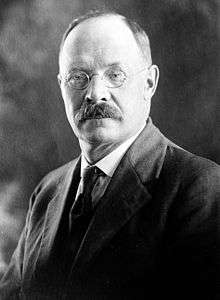Magnus Johnson
Magnus Johnson (September 19, 1871 – September 13, 1936) was an American farmer and politician.[1] He served in the United States Senate and United States House of Representatives from Minnesota as a member of the Farmer–Labor Party.[2]
Magnus Johnson | |
|---|---|
 | |
| United States Senator from Minnesota | |
| In office July 16, 1923 – March 3, 1925 | |
| Preceded by | Knute Nelson |
| Succeeded by | Thomas D. Schall |
| Member of the U.S. House of Representatives from Minnesota's General Ticket Seat Five district | |
| In office March 4, 1933 – January 3, 1935 | |
| Preceded by | General Ticket Adopted |
| Succeeded by | General Ticket Abolished |
| Member of the Minnesota Senate | |
| In office 1919-1923 | |
| Member of the Minnesota House of Representatives | |
| In office 1915-1919 | |
| Personal details | |
| Born | September 19, 1871 Karlstad, Sweden |
| Died | September 13, 1936 (aged 64) Litchfield, Minnesota |
| Political party | Minnesota Farmer–Labor Party |
Biography
Johnson was born near Karlstad, Sweden, and his family moved to La Crosse, Wisconsin, United States, in 1891. (Johnson is the only Swedish-born person to serve in the U.S. Senate.) They moved to Meeker County, Minnesota, in 1893.
He worked as a millhand and lumberjack, became a farmer, and by 1913 was the leader of the Minnesota branch of the American Society of Equity and Vice President of the Equity-owned Equity Co-operative Grain Exchange and Farmers' Terminal Packing Co. He served in both the Minnesota House of Representatives and the Minnesota Senate before being elected to the U.S. Senate on the Farmer-Labor ticket, to fill the seat opened because of the death of Knute Nelson. Johnson served in the Senate from July 16, 1923, to March 4, 1925, in the 68th congress. He lost his bid for reelection in 1924. He was elected to the U.S. House of Representatives and served March 4, 1933, to January 3, 1935, in the 73rd congress, winning one of the general ticket seats. Subsequently, he resumed agricultural pursuits and served as state supervisor of public stockyards 1934 – 1936. He was an unsuccessful candidate for the Farmer-Labor nomination for Governor of Minnesota in 1936.[3]
Johnson died in Litchfield, where he had gone for medical treatment, on September 13, 1936, and his interment is in Dassel Cemetery, Dassel, Minnesota.
See also
- List of United States Senators born outside the United States
References
- Brown, Curt (November 1, 2014). "Minnesota History: The most interesting state politician you might not have heard of" (PDF). Star Tribune. Retrieved 22 May 2020.
- "Magnus the Great". Time. 1923-07-23. ISSN 0040-781X. Retrieved 2020-05-22.
- Minnesota Legislators Past and Present
External links
| Wikimedia Commons has media related to Magnus Johnson. |
- Magnus Johnson at Find a Grave
- United States Congress. "JOHNSON, Magnus (id: J000161)". Biographical Directory of the United States Congress.
| Party political offices | ||
|---|---|---|
| Vacant Title last held by David H. Evans |
Farmer–Labor nominee for Governor of Minnesota 1922 |
Succeeded by Floyd B. Olson |
| First | Farmer–Labor nominee for U.S. Senator from Minnesota (Class 2) 1923, 1924 |
Succeeded by Ernest Lundeen |
| Preceded by Floyd B. Olson |
Farmer–Labor nominee for Governor of Minnesota 1926 |
Succeeded by Ernest Lundeen |
| U.S. Senate | ||
| Preceded by Knute Nelson |
U.S. senator (Class 2) from Minnesota 1923–1925 Served alongside: Henrik Shipstead |
Succeeded by Thomas D. Schall |
| U.S. House of Representatives | ||
| Preceded by General Ticket Adopted |
U.S. Representative from Minnesota General Ticket Seat Five 1933–1935 |
Succeeded by General Ticket Abolished |
